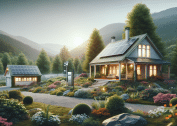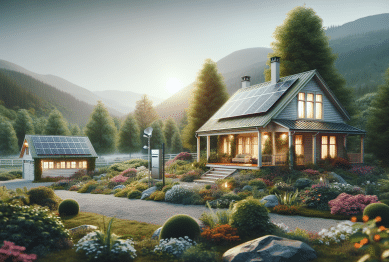Ever wondered how a small outdoor space could feel spacious and lush? This guide explores resourceful small garden ideas, optimal plant choices, and straightforward design tips. Find inspiration for maximizing every inch of your home garden and create a retreat that surprises guests — all while weaving in the essence of green living at home.
Maximizing Limited Space in Your Garden
Utilizing a small garden efficiently begins with understanding its unique potential. A compact place can seem restrictive, but creative solutions offer brilliance. Vertical gardening is one of the most popular strategies in modern home and garden design. By growing upwards—using trellises, walls, or vertical planters—gardeners unlock fresh room for flowers, herbs, or even vegetables. Not only does this method save ground space, but it also introduces visual intrigue, drawing the eye skyward and making the area appear larger. Versatile vertical structures adapt to balconies, patios, or narrow yards, enabling convenient access while also encouraging green living at home. Those who embrace vertical gardening often discover a new world of options that wouldn’t fit on ordinary beds or lawns.
Mirrors, reflective accessories, and light-colored walls are transformative in small gardens. Strategically placed mirrors can create the illusion of extra depth, making a cozy yard feel surprisingly expansive. Pale stones or whitewashed brickwork help bounce light, brightening shaded corners and giving the entire area a fresh, open feel. Layered planting also elongates the space visually. By organizing greenery into low, mid, and tall heights—where groundcovers hug the earth, medium plants form a lush middle, and climbers take center stage—gardeners compose depth, movement, and a truly immersive effect. Layering invites pollinators, improves biodiversity, and ensures that every inch has a purpose, no matter how limited the actual dimensions appear.
Adaptability remains central for anyone wanting easy small garden ideas at home. Fold-away furniture, collapsible planters, and movable containers allow for instant changes as seasons shift or more guests arrive. Raised beds offer increased planting depth and can be used to divide outdoor space into functional zones, such as dining, resting, or vegetable growing. Integrating multi-purpose features—like benches with underneath storage or planters doubling as privacy screens—makes efficient use of every corner. Each thoughtful tweak supports the enjoyment and functionality of the garden, proving that even the smallest plot can be a home retreat to savor.
Selecting Plants That Thrive in Small Spaces
Choosing the right plants is vital when working with limited garden space. Dwarf or compact varieties naturally suit smaller environments because they rarely outgrow their spot, ensuring tidy, visually harmonious displays. Many modern cultivars are bred specifically for container or balcony life, including tomatoes, blueberries, roses, and vibrant miniature conifers. Perennials like lavender, heuchera, and hellebores provide long-lasting structure and interest, while annuals such as marigolds or petunias infuse seasonal color splashes. Mixing these with herbs ensures your space is both attractive and practical. Discover what thrives in certain climates using helpful resources from horticultural societies or regional gardening extension programs (https://www.rhs.org.uk/gardens/advice/profile?pid=708).
Container gardening further expands the range of possible plants regardless of the ground situation. Pots, troughs, hanging baskets, and window boxes enable rapid rearrangement and seasonal changes. This is ideal for renters or those who might move homes. Growers often select Mediterranean herbs, trailing succulents, or colorful annuals that spill gracefully over edges. Regular refreshing of soil and routine watering are required, but drainage is simple to control. Container gardens can even be used indoors on sunny windowsills, creating a seamless flow between indoor and outdoor living for plant enthusiasts with limited real estate.
For households seeking sustainability, edible crops often fit wonderfully among decorative selections. Strawberries tucked among boxwood, leafy greens under taller stems, or upright chillies add edible interest and delight children and adults alike. Companion planting saves space and reduces pests naturally. Some gardeners use clever combinations, such as marigolds beside tomatoes or chives with carrots, to improve plant health and flavor. The integrated approach not only makes efficient use of a small garden but also supports pollinators, supporting a thriving mini-ecosystem even in limited quarters.
Design Tips for Visual Impact in Small Gardens
Eye-catching design doesn’t require a sprawling backyard. Small-garden design thrives on focal points, repeating colors, and layered textures. Placing a sculptural feature, water bowl, or striking planter at the end of a path draws visitors through space. Curved lines—whether in pathway layouts or rounded raised beds—help soften the garden’s boundaries, making the area feel organic and less boxy. Cohesive color schemes using greens and cool tones expand the perception of size, while splashes of hot color offer stunning highlights. Consistency invites calm whereas bold accents keep the garden far from boring.
Repetition is powerful in design. A simple motif—like matching pots or repeated clusters of a single flower—unifies the look. This trick, combined with limited color palettes, prevents the garden from feeling cluttered. Varying leaf textures—from glossy to matte, spiky to soft—enhances visual richness. Mixing hardscape elements such as slate, gravel, or rustic wood with foliage further increases interest without overwhelming the senses. Lighting also matters. Subtle solar lanterns, fairy lights, or recessed ground lights highlight pathways, containers, or walls after dark, inviting evening enjoyment and maximizing usability.
Designing for all the senses heightens the garden experience. Fragrant plants like honeysuckle or jasmine on a trellis, rustling bamboo, and soft mosses offer pleasant sounds and aromas. Water features tucked into corners produce soothing trickles, masking city noise. Bird feeders draw wildlife, creating movement and connection. By combining visual, auditory, and tactile elements, even the tiniest garden becomes an inviting escape from daily routines, continually revealing new details as the year unfolds.
Simple DIY Projects to Refresh Any Outdoor Space
Want a fast but meaningful change? Consider raised beds using recycled timber or planters made from repurposed materials. Pallets can become vertical herb walls or modular furniture. Small, budget-friendly water features—like a sealed pot turned pond—bring tranquility without major expense. Achievable DIY projects empower gardeners to personalize outdoor areas and nurture creativity. Projects like pebble mosaics or tiled stepping stones introduce bursts of color and texture, further inviting exploration.
Trellises and screens offer structure while supporting climbing plants or separating zones for distinct functions, such as seating and planting. Bamboo, willow, or recycled plastic latticework are popular for their flexibility and visual interest. Painting fences or the back of sheds in cheery or soft pastel hues can update the look dramatically. These touches act as low-cost means of transformation, amplifying brightness and reinforcing your design vision. Seasonal decorations or lanterns enhance atmosphere, especially during evening gatherings.
Outdoor furniture doesn’t have to be store-bought. Benches made from concrete blocks and timber planks suit many settings. Stackable crates provide playful, movable seating or double as portable planters. Even small balconies or stoops benefit from folding bistro sets or box cushions. Upholstery with waterproof fabrics ensures durability. Upcycling everyday items is not only sustainable but gives character, showing how anyone can build a personalized and functional garden retreat—no matter how small the footprint may be.
Maintaining a Thriving Small Garden Throughout the Year
Maintenance in a small garden is more manageable but still requires thoughtful planning. Regular pruning, deadheading, and trimming of shrubs or flowers keep plants healthy and extend blooming periods. Mulching suppresses weeds and retains moisture, particularly valuable in confined spaces where soil can dry quickly. Drip irrigation or compact soaker hoses facilitate efficient watering, preserving resources and reducing effort. Simple routines mean even novice gardeners can enjoy a consistently flourishing outdoor haven.
Seasonal adjustments help maintain vigor year-round. In spring, containers benefit from new potting mix and slow-release fertilizer. During summer, frequent checks for pests—such as aphids or slugs—allow for early intervention using eco-friendly remedies. Autumn may see leaf collection and preparing tender varieties for overwintering. Winter is a chance to plan new projects, clean tools, and dream up plant combinations. This cycle ensures resilience, with each step supporting a joyous return of life come the following season (https://www.rhs.org.uk/advice/profile?pid=106).
Sustainability practices shine in compact gardens. Home composting reduces waste and enriches soil affordably, while integrated pest management minimizes chemicals. Companion planting, water catchment, and native species foster ecological balance and make gardening both rewarding and responsible. These holistic habits provide a powerful sense of accomplishment, as sustainable choices benefit the home, local wildlife, and the wider community—a true win for everyone who values the future of gardening at home.
Resources and Inspiration for Your Small Garden Journey
Joining a local gardening club or online community introduces you to tricks, plant swaps, and support from fellow enthusiasts. Social media platforms and gardening forums showcase creative projects, sharing ideas tailored for apartment balconies, urban plots, or shared yards. Public botanical gardens and regular open garden days invite exploration, demonstrating design principles and plant combinations suited to smaller settings. Many cities maintain demonstration gardens or offer short workshops—browse city parks or university extension programs to see what’s close by.
Reputable home and garden websites supply planting calendars, troubleshooting guides, and plant profiles. The Royal Horticultural Society, university agricultural extensions, and major arboretums offer reliable, free advice and video how-tos. These resources are invaluable when determining which varieties will thrive or solving challenges like pest outbreaks or unusual weather. Regular reading inspires innovative thinking while boosting confidence in every new gardener.
For deeper dives, books on container gardening, urban permaculture, and sustainable planting abound at libraries or outdoor retailers. Podcasts and online video channels document personal journeys and design experiments, offering both cautionary tales and inspiring outcomes. The learning never ends; that’s part of the excitement. With time and curiosity, each small garden evolves—and those who tend it grow right alongside their flourishing foliage.
References
1. Royal Horticultural Society. (n.d.). Small Gardens. Retrieved from https://www.rhs.org.uk/gardens/advice/profile?pid=708
2. National Gardening Association. (n.d.). Small Gardens Guide. Retrieved from https://garden.org/learn/articles/view/3972/
3. PennState Extension. (n.d.). Gardening in Small Spaces. Retrieved from https://extension.psu.edu/gardening-in-small-spaces
4. Royal Horticultural Society. (n.d.). Year-Round Garden Maintenance. Retrieved from https://www.rhs.org.uk/advice/profile?pid=106
5. Cornell University. (n.d.). Home Gardening: Small Spaces. Retrieved from https://gardenbasedlearning.cornell.edu/resources/gardening-how-to/small-spaces/
6. University of Illinois Extension. (n.d.). Small Space Gardening. Retrieved from https://extension.illinois.edu/containers/small-space-gardening









